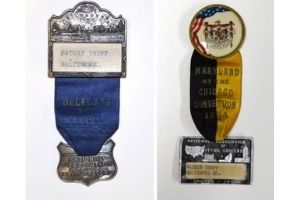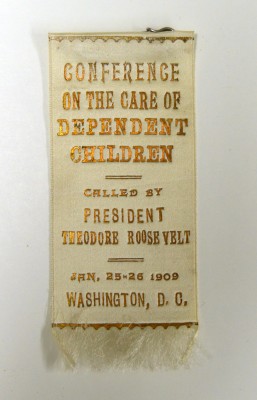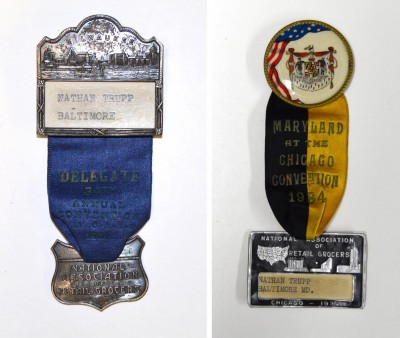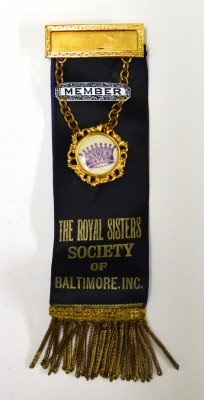Fancy Conference Badges, 1909-1937

A blog post by Collections Manager Joanna Church. To read more posts by Joanna click HERE.
Tomorrow is the first day of the 2016 Annual Meeting of the American Alliance of Museums, held this year in Washington, D.C. Many of us are planning to attend, and in the upcoming days you’ll see plenty of social media updates as we enjoy several days of camaraderie, learning, and swag from the Expo Hall.
When we register tomorrow, we’ll get our nametags, printed clearly on heavy paper and perhaps strung on a nice branded lanyard. Now, I know that organizing several thousand badges is neither simple nor inexpensive, but for a meeting related to museums – many of which include historical collections – it always seems a shame that there’s no nod to the substantial, and considerably more glam, name badges of the past.
I do like an artifact that conveniently provides its own history, and convention badges of the late 19th to mid 20th century fit that bill. Granted, so do most badges from modern conferences, since the point is to state your name and location regardless of the materials of which it’s made. But while we’ll most likely get a piece of paper slipped into a clear plastic sleeve (which one is, rightfully, encouraged to recycle at the end of the event), our predecessors received a thing, meant to be saved: Satin ribbons with shiny printing, bright colors proclaiming one’s regional or professional allegiance, elaborate metal badges, gold fringe, and other embellishments, usually topped off with a small, discreet slot for the attendee’s name. Many cities had companies devoted to the production of these badges, and a big convention coming to town meant money for them as well as for the associated venues, caterers, and hotels.

Since I’m not likely to get my wish this weekend, here are a few examples from our collection. I hope you’ll never be quite satisfied with your flimsy conference name tags again!

Baltimore’s Jacob Moses, then Judge of the Juvenile Court of Maryland, was invited to speak at this conference in D.C. In his opening address, President Roosevelt urged attendees to “take a progressive stand, so as to establish a goal toward which the whole country can work.” Judge Moses’s speech – which a pencil notation on the top indicates was only to be “five minutes” – was entitled “How the Juvenile Court May Protect the Young Child.”

Right: Satin ribbon with enamel and metal badges. “Maryland at the Chicago Convention 1934. National Association of Retail Grocers. Nathan Trupp, Baltimore, Md.” Both gift of Irwin Kramer. JMM 2006.31.12, .15
Nathan Trupp of Baltimore served as President of the Maryland Grocer’s Association in the 1930s. He attended several National Association conferences across the U.S. In 1931, in Milwaukee, President Hoover sent greetings to the foreign attendees on behalf of U.S. delegates; in 1934 in Chicago, attendees were able to enjoy the Century of Progress International Exhibition.

The Royal Sisters Society of Baltimore was founded in 1937 by Mollie Gresser, Reba Cooper, and several others. It was a philanthropic group, raising funds for various worthy causes around the city – but it was also a sisterhood, with formal meetings and regulated membership. The slip of paper announcing this particular member’s name is gone, unfortunately.
